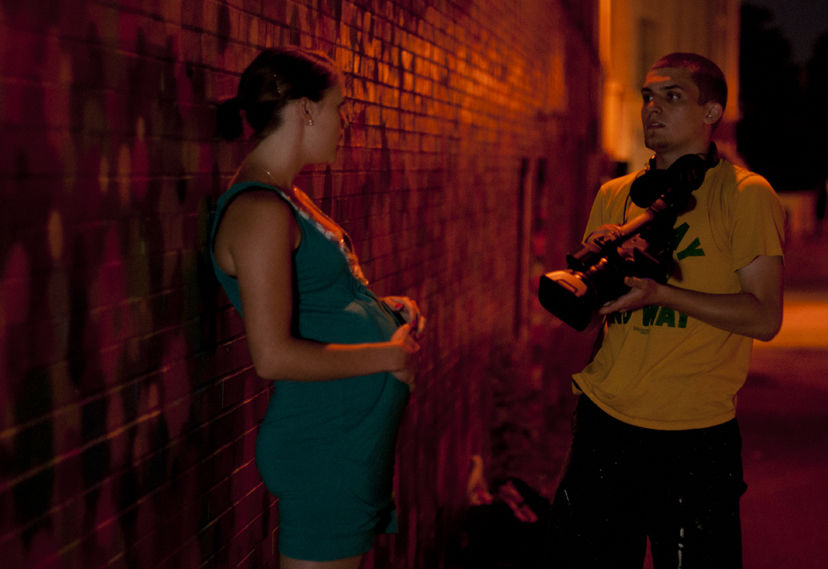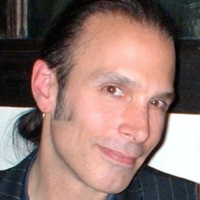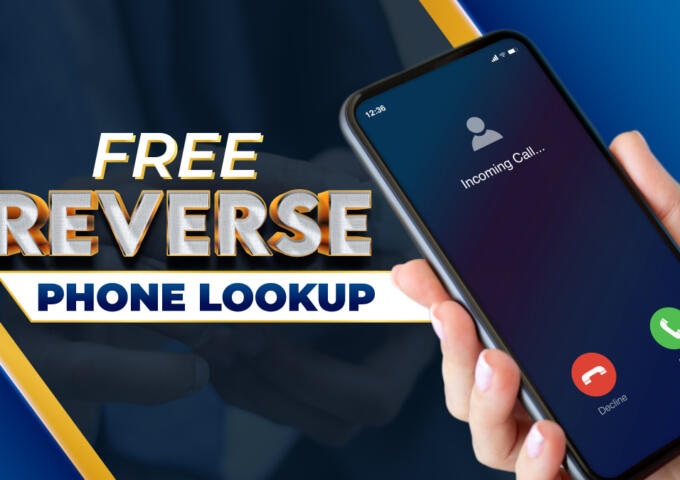One of the starkest realties of first-time director Stephen McCoy’s “Nightcrawlers,” a documentary premiering at PhilaMoca on June 27, is how graphically it portrays the speed with which one can throw youth away, and how homelessness and opioid addiction — twin scourges of the 21st Century — affect us.
Needles poked into flesh and the squalor of street living is but the tip of the horrors within “Nightcrawlers.”
McCoy, then a Boston high school senior celebrating all the stoned/drunk effusion of youth, was on the cusp of adulthood, having just lost his father and receiving a Hi8 camcorder as a graduation present. Maybe making movies would be a way to hang on to his sanity. The then 18-year-old McCoy — influenced, knowingly or not, by Larry Clark (“Kids”) and Harmony Korine (“Gummo”) — embarked on his quest: to capture his environment in as raw a fashion as possible.
As he moved further into filming Beantown’s downtown, McCoy discovered the grimmer reality of the homeless and addicted, the nightcrawlers. This smooth-faced kid became attracted to the scraggly old, and the young, on the street who were pimping, whoring and hustling while looking for their next fix, scrap or (never truly) resting place.
As filming went on for years and the sadness in his life mounted, McCoy grasped onto these street fellows while merging with their environment. Their life became his life. As he filmed, he became homeless and addicted to heroin. As he lost his old family and friends, the nightcrawlers became his new family.
By filming’s end, with all 80 hours of footage, McCoy, the streets and his documentary became one.
Without score or editing, “Nighcrawlers” feels as if it’s ripped from someone’s hands, stolen out of someone’s soul.
“If the film wasn’t made with empathy, it would try to make you cry. We’d have a score, follow Netflix documentary structures and be heartless in the Tin Man pursuit of a heart,” said Luc Benson, the film’s editor. “I can’t guarantee that the audience now will empathize with Stephen or understand addiction more deeply, but I can guarantee they will be able to feel authentically and for themselves.”
‘SELF SABOTAGING NATURE’
Philly is no stranger to rampant homelessness and opioid addiction. Between the City of Philadelphia’s most recent headcount and reports from the U.S. Department of Housing and Urban Development, there are roughly 1,000 people living on Philly’s streets, shelter-less and addicted.
Philadelphia filmmaker Kevin Ronca is no stranger to sudden homelessness and addiction. He went from being thrown out of his suburban household while going off to college to living on the streets of West Philly while in the grasp of oxys and percs That he was able to quit the addiction and parlay his problems into a California film school scholarship from a major Hollywood player AND live to tell McCoy’s tale as producer of “Nightcrawlers” would be the stuff of cinema, if it wasn’t so bleak in its reality.
“Stephen’s Icarus-like tale of flying too close to the sun with this film and ending up an addict largely reminded me of how I lived my life,” said Ronca when asked if McCoy’s downward spiral resembled his own. “I had a self-sabotaging nature.”
Quoting Beat godfather William S. Burroughs, Ronca said, “‘Every human is a parasitic being that doesn’t act to his own advantage.’ That is where Stephen and I really shared a lot of traits. A few wrong turns and you find yourself trapped.”
Ronca’s wrong turns began when the King of Prussia/Collegeville-raised youth got thrown out of his parents’ house before attending the Restaurant School at Walnut Hill College of Culinary Arts between 2007 and 2008. He was a rowdy kid, and his parents weren’t having it. He went to the Restaurant School, not because he wanted to be a chef, but rather to get away from home and find something close in spirit to his dreams of film school.
“I saw an art in food close to the filmmaking thing I longed for. But, understandably, my parents didn’t see that I had really applied myself in high school, so they weren’t about to send me across the country to film school,” he said.
He discovered his favorite filmmakers — Kubrick, Coppola and Scorsese — among his parents’ VHS tapes before their divorce. They allowed him to see those cinematic recipes put to the test. With any great film, there must be antagonists, a protagonist and dramatic arcs. When his parents threw him out of the house for being shiftless, and eventually his attendance at college on 42nd and Walnut dwindled, Ronca’s life spun out of control. He wound up living in his car in the Restaurant School’s parking lot and on the streets of West Philly.
“I slipped through the cracks at school. I had forever been a lousy student, and though there was passion for food, I was defiant,” he said.
Ronca drifted. His drug of choice was OxyContin and Percocet 30s. “I never really told my friends this, as there’s a genuine level of shame here,” he said, trailing off. “Percs were normalized. Everyone’s mom had them in their medicine cabinets.”
Did you know? | Between the City of Philadelphia’s most recent headcount and reports from the U.S. Department of Housing and Urban Development, there are roughly 1,000 people living on Philly’s streets, shelter-less and addicted.
He did things he isn’t proud of to keep him alive, and keep him addicted. Though he won’t admit to specifics, Ronca mentioned that many of his survival skills allowed him to break more than a few laws. “I got arrested several times,” he said. “I just dropped out. Of everything.”
And yet, like McCoy’s homeless family life, there were glimmers of hope. “No one from my old suburbs took me in. That parking lot on 42nd & Walnut became as much of a home as I could have,” he said.
Ronca noted how locals looked out for him and made him feel part of the family, similar to how McCoy’s fellow street urchins did for him on the streets of Boston. Ronca sold small bags of weed for quick cash and kept his hand in writing when he could. His love of film never waned, even if his love of self was non-existent. “I kept falling back into bad habits…It felt like an abyss,” he admitted.
Eventually, the circle of endless addiction and criminality got to Ronca, and he finally asked for real help. “I had wasted most of my life. I couldn’t live with that,” he said.
He got his act together enough to beg his parents’ forgiveness, sober up, move in with his mom and get his degree from Montgomery County Community College. He even found the LA film school “leg up” he had always wanted. “My parents saw that I had turned my life around,” he said. “They said if I could find an affordable film school, they’d help me.”
––
“I was in Pasadena, nearly broke, down to $30, when I got this check from Zach Snyder.“Why the fuck would the guy from ‘300’ send me money?”
– Philly filmmaker Kevin Ronca on winning a collegiate film award
––
Ronca found it in Pasadena’s ArtCenter College of Design, a college with illustrious alumni such as Linkin Park’s Mike Shinoda, macho filmmaker Michael Bay and DC Comics superhero director-producer-writer Zach Snyder. While in attendance from 2015-2017, Ronca won the approval of Snyder without ever meeting the auteur until his graduation day.
“I was in Pasadena, nearly broke, down to $30, when I got this check from Zach Snyder,” Ronca recalled, still in disbelief four years later. “Why the fuck would the guy from ‘300’ send me money?”
It turns out Ronca had been one of four promising students to get alumni scholarship dollars courtesy of Snyder. “Zach’s cash saved my life,” he said.
What does someone with an addictive personality do with big cash? Follow their worst impulses, take half of the money to the Southern Californian Commerce Casino and enter into a poker game two hours after the check arrived, perhaps. “Self-destructive, right? I started out strong… until I was down to my last chips, $50,” he said.
Ronca, a guy with an affinity for gambling (his first short was titled “The Dealer’s Hand”) did what any good and bad gambler would do — double down.
“I caught a full house, but my Jack-Jack-Ace-Ace-Ace couldn’t beat the man across from me’s AAJJJ,” he said. “Hopeless, I started to leave when everyone started yelling. A guy came out and handed me a check, saying I’d received the Bad Beat Jackpot. I left the casino with $12,000, enough to fly myself and a cameraman back to Philadelphia to capitalize on what had become a new obsession and national necessity— 2016’s Democratic National Convention.”
IMPORTANT NEXT STEPS
Ronca and friends from ArtCenter College had formed a collective, Write Brain, and were pursuing a twisted vision of the American Dream with Ronca’s directorial debut, “The Revolution Televised.”
Complete with free narration from Viggo Mortensen, “The Revolution Televised” featured pro-Black Lives Matter narratives and anti-Trump everything. It brought them notoriety and a few ducats. Inspired not by what people could do with $20 million but with little cash (“Roger Corman and John Waters are my heroes in that respect,” Ronca said), Write Brain wanted to make its next film more universal and human.
That’s when they pulled out a sample of loose footage they’d been sent — 80 hours of Hi8 camcorder-shot film — called “Nightcrawlers.” They then hunted down McCoy, the supposedly homeless guy who made it.
Ronca found him in a Boston homeless shelter doing his best to edit on “his beat-up, old ass laptop,” Ronca said. “I don’t know why — call it instinct — we got money together and flew McCoy out to live with me while Luc and he edited ‘Nightcrawlers.’”
Write Brain collective member-editor Benson called the deep dive through McCoy’s footage rough going. “There is sadness there,” he said.
“The first night Stephen stayed with us, Kevin and I accidentally found footage of his overdose while going through the tapes he had brought,” Benson said. “Stephen was sleeping on the couch next to us. We didn’t even know that footage was in there. I know that was deeply troubling. There is another scene where Stephen cuts his finger with a razor blade for the camera. I couldn’t look at it without getting nauseous, so I left the full clip in without cutting, so I would have to look at it less. But that lack of editing ends up functioning positively. Film has a natural affinity for the real in that way, so the nausea helped in the editing.”
Ronca is still amazed that he took in a total stranger with what McCoy stated was mental problems. “Some of the collective were skittish about him,” he said. “He had a homeless guy’s instincts, which I recognized immediately. He and I had similarities, both being from the East Coast, both going through the homeless thing. He’s still going through it.”
When asked about the amount of blood, sweat and tears that went into “Nightcrawlers,” Benson noted that it was McCoy that did most of the bleeding. “After staying with Kevin for a few months, he went back to Boston for a court date — I believe it was for kicking a cop while drunk — and one day in the middle of class, I get a call from Kevin saying that Stephen was in the hospital. He got stabbed in the chin. Next time we saw him, he had stitches. So Stephen was the one drawing blood. The whole film runs on Stephen’s blood, and his impulse to document it.”
Benson doesn’t harbor the demons that Ronca and McCoy do, but he was drawn to McCoy through the very people that this first-time director documented. ”It’s less me being drawn to a unified community than it is me being drawn to the splinters,” Benson said. “Stephen is a splinter.”
Ronca is also a splinter. He knows what it is to be a guy with his whole life in a bag. “When I picked him up, it was his tapes and these shirts,” Ronca said. “I knew what and who he was, how volatile he could be. To be honest, I slept with a knife under my pillow when I first brought him into the house. He would wake up screaming, as he thought he was still living in the homeless shelter… real post-traumatic stress disorder stuff. But if my folks and Zach Snyder hadn’t have given me a second chance, I wouldn’t be here, so….”
Often spoken of in the third person, McCoy, for his part, lives life very much in the first person, despite any problems or discussions of his demons.
“I was 18 when I conceptualized this idea of making a film about the city at night, not an original idea by any means, but it was something I could build off of, play with,” McCoy said. “I could wander. I would carry two handheld cameras and I would just walk and record. I never approached it with a sociopolitical attitude. I didn’t go out looking for the people I encountered. They were just there. I was neither a man nor an artist at this point. I was just a kid with a video camera.”
Asked about meeting the people he became close to from the “Nightcrawlers” community, and how he became one with their addictions, McCoy is frank. “In the beginning, I made a conscious choice that I would only film and interview the people i met for that brief encounter and moment and nothing more, but the more you travel by foot, the more you become enveloped in your surroundings,” he said. “I guess it’s a question of how deep will you go, how willing are you to become totally immersed? I mean, you travel around certain circles enough, you’re bound to make some relationships. Some people improve, and others, unfortunately, aren’t so blessed.”
$12,000 | The amount of money Philly filmmaker Kevin Ronca walked away from a California casino after betting away awarded film scholarship money on a poker game.
Of his own circumstances, he is quick to say that addiction and finding himself among the homeless didn’t happen overnight. “I kept gradually falling deeper and deeper down the rabbit hole,” he said. “After a certain point, things like my health, family, friends, didn’t quite matter anymore. Death no longer seemed something worth fearing. In fact, it was almost embraced as a way out. I started out wanting to create cinema that celebrates the beauty of living, not the other way around.”
Hooking up with Ronca, someone who understood the pitfalls of addiction and homelessness, was a blessing and a necessity. “[The manner in which he’s willing to put his demons out there] is just an example of how we function as collaborators and friends,” McCoy said. “We are both the kind of individuals that believe that somethings are simply not worth doing unless there’s a certain sacrifice involved. If you’re not giving up a piece of yourself in the process, you have no room to grow. Luckily, I have people in my life today that are showing me how to dream again. I don’t think i can do anything but make film, but what that film will look like, only time will tell.”
Talking about the empathy it took to undergo its production, Ronca is pragmatic.
“Moving to LA, I was surrounded by people that didn’t understand my struggle… the plague of addiction that was killing people where I grew up, and leaving so many dying in the streets in Kensington,” he said. “I was looked at with shock and surprise. When I met Stephen… He didn’t give me that look of surprise. There was a normality of homelessness and this epidemic… Not normality. but empathy and understanding. He had seen that struggle. He had lived that life. We had both been to rock bottom and seen the pits. I had a heart attack at 25. Stephen OD-ed. I was nomadic, with nowhere to go. So was Stephen. I had a felony, so did Stephen, facing serious jail time, too. I hadn’t felt that kind of connection of someone understanding my struggle the 3 years I had been living in LA… until I met Stephen. That loneliness I felt before drifted away… and McCoy became a brother to me forever.”
TWITTER: @ADAMOROSI





